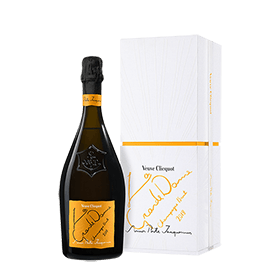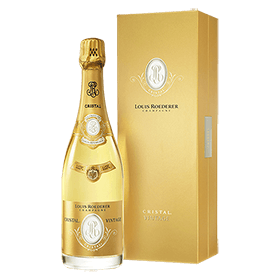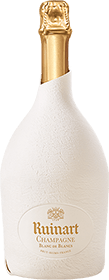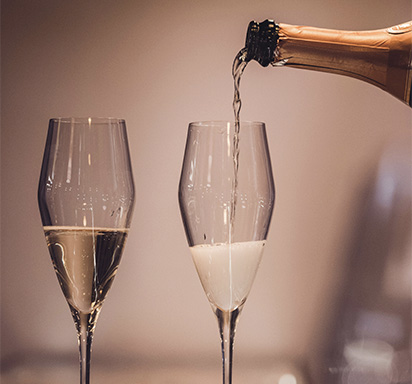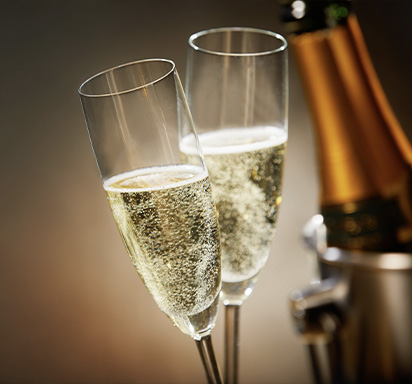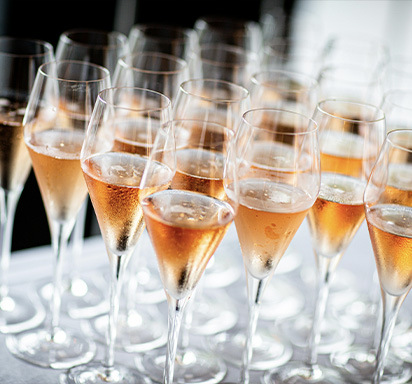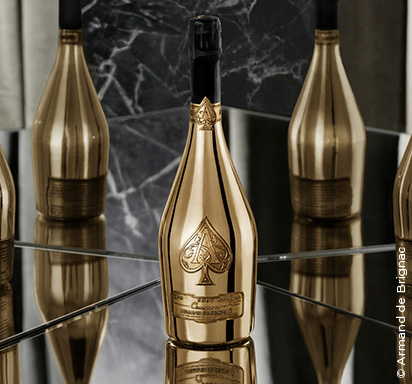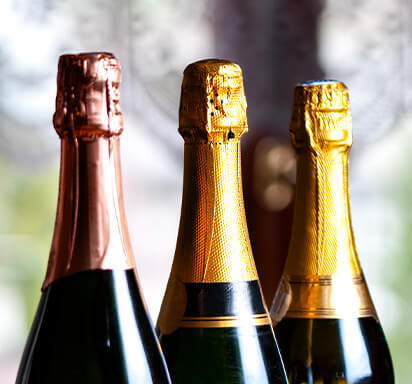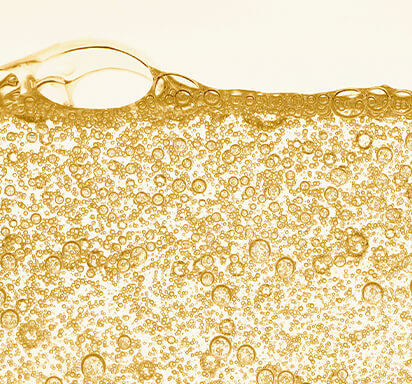Champagne: How to hold a Champagne glass?
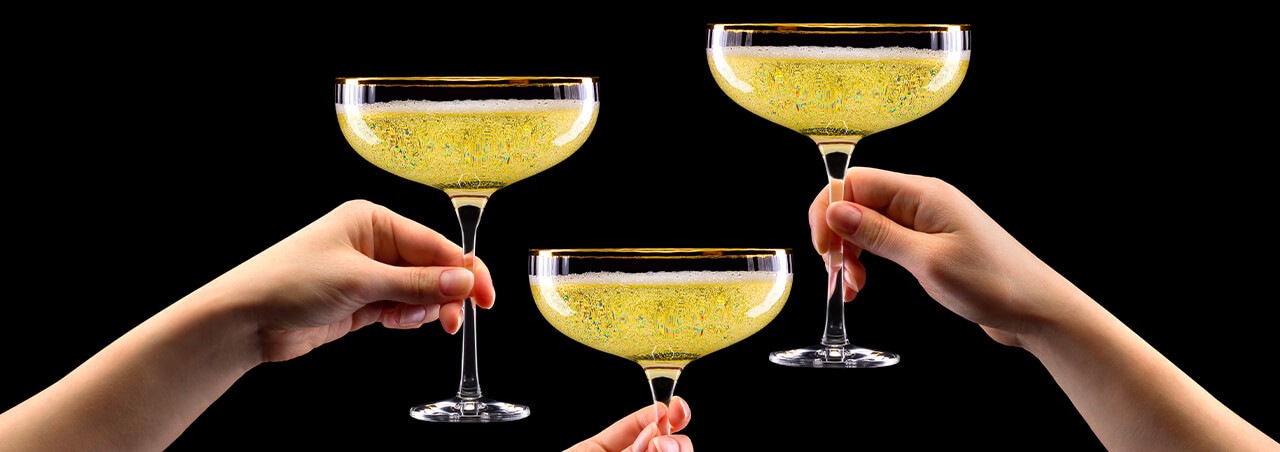
In this article we discuss types of champagne glasses and how to hold a wine glass. We’d like to preface the article by mentioning that we do not believe anyone should be judged for the way they hold their glass.
The most festive and sought-after sparkling wine in the world, Champagne often makes an appearance at special celebrations like weddings, birthday parties and family reunions. But have you ever wondered about the best ways to hold a Champagne glass? A wine that shines best when chilled, offering a fine thread of effervescence and delicate aromas, Champagne should be treated with care to ensure maximum enjoyment.
In this article we discuss types of champagne glasses and how to hold a wine glass. We’d like to preface the article by mentioning that we do not believe anyone should be judged for the way they hold their glass. What follows are simply some suggestions to make the best of your wine tasting experience.
WHY IS HOLDING A CHAMPAGNE GLASS CORRECTLY IMPORTANT?
To fully understand the importance of holding Champagne glasses correctly, we must first understand what is Champagne and what its tasting entails.
Champagne is a sparkling wine, which means that it is carbonated. The bubbles are an important part of the tasting experience, so it is advisable to maintain a constant stream of them for as long as possible. The method for holding a champagne glass affects the behavior of the bubbles, which is why it is important to choose right. For example, warming up the glass leads to a faster loss of carbonation, so it is important to avoid doing so to preserve the fizz.
Champagne from top Champagne brands have the potential for very complex and nuanced aromas. The type of glass and the way of holding the glass affects the intensity with which these aromas come through. It is therefore important to choose the right glass for your tasting experience and to hold that glass correctly.
Finally, Champagne is a liquid, and like any liquid, it can be spilled. Holding glasses of champagne or any wine correctly prevents spillage of the precious liquid inside.
THE THREE TYPES OF CHAMPAGNE GLASSES
Champagne or sparkling wine is most commonly served in one of three different types of glassware. The optimal hand-holding champagne technique will depend on the shape of your glass of champagne. Let’s take a look at these three different wine glasses, commonly used for drinking champagne or white wine that sparkles.
• The Champagne Flute
Champagne flutes are by far the most popular choice to drink champagne from. The champagne flute features a long, thin wine glass stem and a tall, narrow bowl. This glass shape was designed to guide the natural effervescence (bubbles) in champagne to the surface, while also preserving carbonation in your glass of bubbly. It is also the safest choice at large events, since its narrow surface minimizes spillage. However, this glass isn’t necessarily the best for enjoying the aromatic nuances in a glass of champagne.
• The Coupe Glass (or Champagne Saucer)
The champagne coupe was the original champagne glass, popularized in England during the 1830’s. This glass features a short stem and a shallow, broad-rimmed bowl. It has a vintage feel and is a great choice in the case that you want to build a festive champagne tower.
While the wide bowl allows the taster to better appreciate the aromas of a champagne, it also leads to a faster loss of carbonation. Simply put, champagne served in a coupe glass goes flat faster. The coupe glass is also the most difficult to hold onto without spilling its contents, especially in a room full of people, due to its top-heavy weight distribution and wide opening.
• The Tulip Glass
The tulip glass is the glass most commonly used by wine industry professionals and was specially designed to bring together the best features of both the flute and coupe glasses. Similar to the flute glass and to a glass of white wine, the tulip glass features a long stem and a tall bowl. However, these glasses have a wider bowl, which allows the aromas of the champagne to come out and a tapered lip, which slows the loss of carbonation and prevents spillage.
Note : If you do not have either of these three Champagne glass types, do not fret. Just use your favorite white wine glasses.
FOUR WAYS TO HOLD A CHAMPAGNE GLASS
When choosing the right way to hold a glass of Champagne wine, it is important to avoid warming up the contents of your glass and smudging the glass with your hand. As a Champagne glass has four main parts, it only makes sense that there are four main ways to hold the glass. However, as you will see, some methods are more advisable than others.
• Hold by the Stem
By far the best wine glass hold for a champagne glass or white wine glass is by the stem. Pinch the stem between your thumb and forefinger around half an inch below where the stem meets the base of the bowl. Allow the other three fingers to rest at the base or on the same side of the stem as your forefinger. Your thumb and forefinger should bear most of the weight, while the rest of your fingers stabilize the grip.
To take a sip of champagne, use your wrist to tilt the glass at a 45 degree angle and place your lips to the rim of the glass. By the stem is by far the best option when it comes to the ways to hold a champagne flute or tulip glass, because it prevents warming the wine with your hand and smudging the glass. However, it may be complicated to hold by the stem when it comes to a top-heavy coupe glass.
• Hold by the Rim
As a Champagne glass should only ever be 75% or less with Champagne, it is technically possible to hold it by the rim without warming up the contents with your hand. This way of holding a glass works with a flute or tulip glass, but not with a coupe glass whose wide rim makes it difficult to fit in your hand.
While this technique keeps the wine inside cool, it has two drawbacks. For one, it will lead to smudging the rim of the glass with your finger. Also, holding the glass by the rim blocks this area of the glass, making it difficult to fit one’s lips to take a sip. It is therefore not an advisable way to hold a champagne glass.
• Hold by the Bowl
Holding a champagne glass by the bowl leads to a transfer of heat from your hand to the contents of the glass. When you warm up a glass of champagne, you speed up the loss of carbonation and increase the effects of alcohol on the nose, which might overwhelm the more delicate aromas of the champagne. It is thus advisable to avoid holding a glass of champagne by the bowl at all costs.
While it is easy to avoid holding the bowl of a flute or tulip glass, it is not so simple with a top-heavy coupe glass. If you must use a couple glass, you may hold it partially by the bowl in order to prevent spilling the champagne.
• Hold by the Base
The final way to hold a flute or tulip champagne glass is by the disk-shaped base at the bottom of the glass. These bases are typically designed to be quite strong, so do not worry about breaking the glass of wine this way. To hold a glass by its base, pinch the base between your thumb and the rest of your fingers so that your thumb is on the top side of the base and the rest supporting the grip underneath the disk.
This glass hold prevents warming the champagne and smudging the glass. However, it makes it difficult to put the champagne down without the use of your other free hand. Also, avoid using this grip when it comes to coupe glasses, since the wide bowl will make the wine difficult to balance and more likely to spill.
HOW TO SIMULTANEOUSLY HOLD A CHAMPAGNE GLASS AND A NAPKIN
In the case of certain champagne tasting experiences, it can be beneficial to leave part of your hand free to hold additional objects, like a napkin or plate. In order to do so, rest your champagne glass between your ring finger and pinky. This frees up your thumb, forefinger and middle finger, which can then hold an additional item. This only works, however, when you’re not sipping on your champagne.
Alternatives to holding your champagne are setting it down temporarily on a nearby stable surface, like a table or counter. You may also use a hands-free wine glass lanyard with a strap that goes around your neck to sustain your glass in the moments between sipping. For a continuous wine tasting, however, we recommend holding the glass by the stem..
Are you wondering “Where can I find champagnes near me?” Take a look at our complete online Champagne selection. Or, visit our New York City store to find these sought-after bottles of bubble! And if you have any more questions about opening a Champagne bottle, pouring Champagne, choosing the right glassware or how to hold a glass, please reach out to our team directly!
You may like
Brut and Extra Dry Champagne differ in sweetness, with Brut being drier and Extra Dry slightly sweeter. Learn their flavor profiles, food pairings, and which one suits your preference for celebrations and special occasions.
3/17/2025Prosecco and Crémant are both sparkling wines, but their differences lie in production methods, flavor, and origin. Learn about the Charmat and traditional methods, the taste profiles, and the best food pairings for each wine.
1/31/2025Whether you're hosting a small party or a large-scale event, Champagne is the perfect companion for any celebration. But do you know how many bottles to order for your event? Find out now!
1/17/2025Armand de Brignac, the "Ace of Spades," blends centuries-old winemaking by the Cattier family with Jay-Z's flair. Known for its luxurious taste and iconic hand-finished bottles, it offers five prestigious cuvées.
10/8/2024Nothing screams celebration quite like popping open a fine bottle of Champagne at one of your special events. But how do you choose a bottling that matches your event? For a wedding, a meal with friends or a birthday celebration..
4/3/2023Champagne (or sparkling wine in general) is the wine of choice when it comes to celebration. But what sets it apart from the other fine wines of the world? The answer is simple: the bubbles.
3/7/2023

